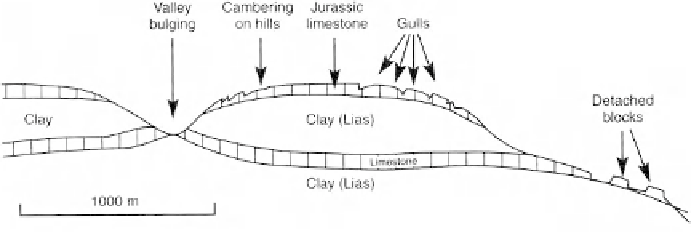Geology Reference
In-Depth Information
Pleistocene. At those times, this part of central Europe lay to the south of the main
Baltic-West Siberian ice-sheet complexes.
12.3.5. Non-Diastrophic Structures in Bedrock
At a similar scale to the diapiric lignite deformations described above are non-diastrophic
structures that occur in relatively consolidated bedrock. These were fi rst given Pleis-
tocene, or periglacial, signifi cance by bedrock geologists in the U.K. (Hollingworth et al.,
1944; Kellaway, 1972). The structures take the form of gently-dipping strata adjacent to
valleys (cambering), up-arching of strata in valley bottoms (valley bulging), and the forma-
tion of expanded joints (gulls) in coherent bedrock which appears to have preferentially
moved across plastically-deforming softer sediment beneath (Figure 12.10). The signifi -
cance of these non-diastrophic structures is frequently overlooked by geomorphologists
involved in Pleistocene periglacial reconstruction.
The nature of permafrost creep and its dependence upon temperature has been dis-
cussed in Chapter 9. This information supports the suggestion that deep-seated creep-
deformation in a plastic but still frozen state, as might exist when permafrost temperatures
approach 0 °C, was the cause of these non-diastrophic structures.
Two fi eld examples illustrate the signifi cance of the thaw-rheology of perennially-frozen
ground. First, cambering and valley-bulging phenomena are well developed in the Jurassic
and Cretaceous bedrocks of central and southern England (Dury, 1959, pp. 179-181;
Hawkins and Privett, 1981). These strata show a succession of thick, often over-consoli-
dated, argillaceous rocks separated by more resistant arenaceous and carbonate rocks.
An attractive explanation for these phenomena is that they developed as permafrost
degraded at various times during the Pleistocene (Horswill and Horton, 1976; Whiteman
and Kemp, 1990). Permafrost creep would have been accentuated in the more ice-rich
clay strata because increasing amounts of unfrozen water would become available to
lubricate movement as ground temperature approached 0 °C (see Figure 4.2). The second
example relates to the occurrence of disrupted and broken blocks of bog ironstone that
are found in Tertiary-age gravels in the Pine Barrens of Southern New Jersey, eastern
USA. By its very nature, bog ironstone forms in horizontal layers at the level of the
regional water table. During the Quaternary in New Jersey, it formed continuously and
in accordance with fl uctuations of the groundwater table. Today, where ironstone beds are
encountered near the surface, they are invariably inclined yet at depth are inevitably hori-
zontal. An explanation is that this heavy rock “foundered,” or sank, in the water-saturated
conditions that would have temporarily existed during the thaw of icy permafrost beds
below (French et al., 2003, 2005).
Figure 12.10.
Types of large non-diastrophic structures associated with Pleistocene permafrost in
central England described by Hollingworth et al. (1944) and Dury (1959).

